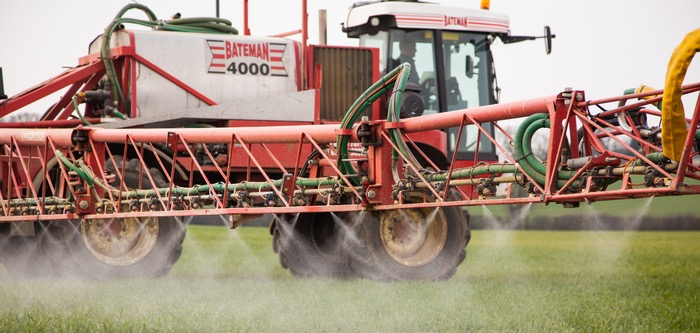In contrast to previous dry springs, rainfall throughout March and April has been above average across much of the UK, resulting in high Septoria pressure, particularly in earlier-sown wheats.
If conditions remain favourable for disease development, Hutchinsons head of integrated crop management, David Howard, says a robust flag leaf fungicide will be vital to take the pressure off T3 sprays – a timing primarily aimed at managing ear diseases, although can top-up foliar protection.
It is, however, very tricky to fully control both ear and foliar diseases with the T3, as the optimum timings are slightly different, he says.
For managing ear diseases, such as fusarium, microdochium and sooty moulds, there is a narrow window of opportunity to treat crops, around full ear emergence, with flowering just beginning in the middle of the ear, (growth stage 63-65).
“Applying fungicides even just a few days beyond that, means you will start to lose control rapidly, although there will still be benefits to foliar protection.”
Whereas, if the priority is on protecting the top two leaves from foliar diseases, such as Septoria or rust, the optimum timing is slightly earlier (typically GS 59), but this is too early for any significant effect on ear diseases, he advises.
“Using prothioconazole or tebuconazole in programme at this earlier timing has been shown to slow ear diseases, but it’s not effective enough.
“Growers therefore need to have applied a robust T2 to protect crops through to full ear emergence, reducing the need to get in early with a foliar top-up.”
T2 options
Generally, the strongest curative options at T2 are either fluxapyroxad + Mefentrifluconazole, or fenpicoxamid + prothioconazole, so Mr Howard says these will be go-to choices in anything other than a low risk situation. Both offer similar Septoria control, so deciding between the two may come down to other factors – e.g. Mefentrifluconazole is slightly better on brown rust, while fenpicoxamid has an edge against yellow rust.

David Howard
Including the multisite folpet can be worthwhile for extending Septoria protection in high pressure situations, and for resistance management, he adds.
Of the older chemistry, AHDB fungicide performance work shows a notable drop in the efficacy of some SDHIs that were once the mainstay of T2 programmes, so growers need to be aware of the changes when choosing products, especially if curativity is needed.
“There is still a place for products based on actives such as bixafen, Fluopyram + prothioconazole, or other bixafen, Fluopyram mixtures, which have shown higher activity than other SDHIs in our trials. But if Septoria pressure becomes significant, higher rates will be required.”
If rust is the focus, rather than curative Septoria control, many products, such as benzovindiflupyr + prothioconazole, offer good efficacy and may deliver some Septoria protection too, he notes.
Ideally the T2 should be applied at GS 39, once flag leaves on main tillers are fully emerged, he notes.
T3 timing complication
Variations in ear emergence can complicate the optimum T3 fungicide timing , Mr Howard says.
“It’s very rare for all ears to emerge at the same time, and with warmer than average temperatures through last autumn, into spring, some crops are racing through growth stages, so ear timing could be quite variable depending on variety, drilling date, and other factors.”
He goes on to reinforce the case for using a T3 fungicide, especially as recent years have shown that disease pressure – Septoria, yellow rust, or brown rust – towards the backend of the season is often much greater than expected.
“We must protect the main yield-building leaves as long as possible beyond the main T1 and T2 fungicide timings, while safeguarding grain quality. Crops can be quite exposed if the weather changes rapidly at the end of the season.”
Fungicide options
Before applying T3s, growers should complete the AHDB mycotoxin risk assessment (https://ahdb.org.uk/mycotoxins), as there are legal limits for fusarium mycotoxins, deoxynivalenol (DON) and zearalenone (ZON), in wheat intended for human consumption, and guidance limits for feed grain.
To manage fusarium (favoured by warm and wet conditions during flowering) and associated mycotoxins, Mr Howard says metconazole, prothioconazole, or tebuconazole, are all good options. AHDB research indicates combinations of prothioconazole and tebuconazole are more effective than single actives alone. For controlling microdochium (cool, wet conditions), prothioconazole is preferred.
“Use a good fungicide dose of at least 50% recommended rate,” he adds.
Including strobilurins, such as azoxystrobin or fluoxastrobin, can be beneficial in either situation, by giving good persistency, helping manage rusts, Septoria nodorum and sooty moulds, and delivering greening benefits.
“Improving green leaf area retention and reducing crop stress can lead to wider yield benefits from the T3, aside from disease control,” he notes.




